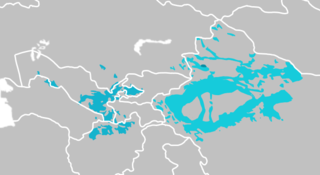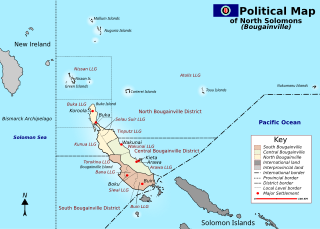Related Research Articles
Ethnologue: Languages of the World is an annual reference publication in print and online that provides statistics and other information on the living languages of the world. It is the world's most comprehensive catalogue of languages. It was first issued in 1951, and is now published by SIL International, an American evangelical Christian non-profit organization.
The Samoic–Outlier languages, also known as Samoic languages, are a purported group of Polynesian languages, encompassing the Polynesian languages of Samoa, Tuvalu, American Samoa, Tokelau, Wallis and Futuna, and Polynesian outlier languages in New Caledonia, the Solomon Islands, Vanuatu, Papua New Guinea, and the Federated States of Micronesia. The name "Samoic-Outlier" recognizes Samoan.

The South Bougainville or East Bougainville languages are a small language family spoken on the island of Bougainville in Papua New Guinea. They were classified as East Papuan languages by Stephen Wurm, but this does not now seem tenable, and was abandoned in Ethnologue (2009).

Ushoji or Ushojo is an Indo-Aryan language spoken in Kohistan and Swat districts of the Khyber-Pakhtunkhwa province of Pakistan.

The Karluk or Qarluq languages are a sub-branch of the Turkic language family that developed from the varieties once spoken by Karluks.

The Jukunoid languages are a branch of the Benue-Congo languages spoken by the Jukun and related peoples of Nigeria and Cameroon. They are distributed mostly throughout Taraba State, Nigeria and surrounding regions.

Buin is a town on Bougainville Island, and the capital of the South Bougainville District, in the Autonomous Region of Bougainville, in eastern Papua New Guinea. The island is in the northern Solomon Islands Archipelago of the Melanesia region, in the South Pacific Ocean.
Central Tibetan, also known as Dbus, Ü or Ü-Tsang, is the most widely spoken Tibetic language and the basis of Standard Tibetan.

South Bougainville District is a district of the Autonomous Region of Bougainville of Papua New Guinea. The district has four local-level governments. Its capital is Buin. South Bougainville languages are spoken in the district.
Terei or Buin, also known as Telei, Rugara, is the most populous Papuan language spoken to the east of New Guinea. There are about 27,000 speakers in the Buin District of Bougainville Province, Papua New Guinea.
Omati, or Mini, is a Papuan language spoken in the Omati River area of Papua New Guinea. The two varieties, Barikewa and Mouwase, are quite divergent.
The Hill Nubian languages, also called Kordofan Nubian, are a dialect continuum of Nubian languages spoken by the Hill Nubians in the northern Nuba Mountains of Sudan.
The Kulu language, Ikulu, also known as Ankulu or Ikolu, is a Plateau language of Nigeria. It is spoken by the Bakulu, found in the Zangon Kataf, Kachia and Kauru Local Government Areas of Kaduna State.
Southern Luo is a dialect cluster of Uganda and neighboring countries. Although Southern Luo dialects are mutually intelligible, there are six ethnically and culturally distinct varieties which are considered to be separate languages socially.
Spurious languages are languages that have been reported as existing in reputable works, while other research has reported that the language in question did not exist. Some spurious languages have been proven to not exist. Others have very little evidence supporting their existence, and have been dismissed in later scholarship. Others still are of uncertain existence due to limited research.
Keninjal is a Malayic Dayak language of Borneo. Glottolog classifies Keninjal as a Western Malayic Dayak language alongside Kendayan, but Smith (2017) includes it in the Ibanic branch of Malayic based on phonological evidence.
Kodi is a Sumba language of Indonesia. The population figure may include Gaura, which Ethnologue counts as a dialect of both the Lamboya and Kodi languages. Kodi is an Austronesian language that is mainly spoken in Nusa Tenggara Timur province, the western part of the island of Sumba in eastern Indonesia. An alternate name for Kodi is Kudi and dialects of the language include Kodi Bokol, Kodi Bangedo, Nggaro (Nggaura) and is most alike to Wejewa. With only approximately 20,000 speakers, the Kodi language is an endangered language.
The Yukubenic languages are a branch of either the Jukunoid family or the Plateau family spoken in southeastern Nigeria. Glottolog places Yukubenic in the Plateau family. Ethnologue, however, places Yukubenic in the Jukunoid family, based on Shimizu (1980), and Blench also follows this classification.
Glottolog is an open-access online bibliographic database of the world's languages. In addition to listing linguistic materials describing individual languages, the database also contains the most up-to-date language affiliations based on the work of expert linguists.
References
- ↑ Uisai at Ethnologue (18th ed., 2015) (subscription required)
- ↑ "Glottolog 2.7 - Buin". glottolog.org. Retrieved 19 January 2017.
- ↑ "Uisai". Ethnologue. Retrieved 19 January 2017.